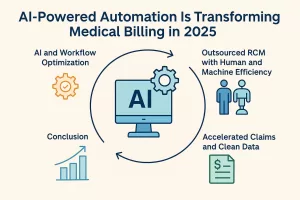Revenue cycle management (RCM) is a critical aspect of healthcare that directly impacts a provider’s financial health. One of the pivotal components of efficient RCM is healthcare payment processing. In this blog, we will delve into how an effective payment processing system can boost RCM, ensuring smoother operations and increased revenue for healthcare providers.
Understanding Revenue Cycle Management
To appreciate the role of payment processing, it’s essential to first understand what revenue cycle management entails and its significance in healthcare.
Revenue cycle management encompasses all the administrative and clinical functions that contribute to the capture, processing, and collection of patient service revenue. This includes everything from scheduling appointments to handling claims submissions and managing the billing process. Effective RCM not only ensures that healthcare providers get paid for the services rendered but also plays a crucial role in ensuring patient satisfaction and operational efficiency.
Moreover, a thorough understanding of RCM highlights the importance of integrating technology into these processes. Healthcare providers who effectively leverage technology can streamline operations and reduce the time and resources needed to manage their revenue cycles.
The Role of Payment Processing in RCM
Healthcare payment processing is vital for tracking patient payments, managing claims, and streamlining the entire billing process, thereby enhancing RCM.
An efficient payment processing system helps healthcare organizations smoothly transition from the treatment phase to the payment phase. This means fewer delays and a reduction in the chances of errors that could arise during the billing process.
Additionally, payment processing facilitates the meticulous tracking of transactions, making it easier to manage finances effectively. It acts as a bridge connecting patient services to revenue, ensuring that every service rendered is accounted for and appropriately billed.
Key Benefits of Effective Payment Processing
Implementing efficient payment processing can lead to faster reimbursements, improved cash flow, and reduced administrative costs—benefits that are crucial for optimizing RCM.
When payment processing is streamlined, healthcare providers can expect to see faster payment turnaround times. This means less cash flow strain and the ability to allocate resources more effectively, directly impacting overall financial health.
Furthermore, effective payment processing ensures that claims are submitted accurately and timely, leading to higher approval rates. This reduces the number of claims denials, which can often be attributed to errors in data entry or incorrect coding.
In the long run, all these advantages not only enhance the organization’s financial standing but also foster trust and satisfaction among patients, who appreciate efficient billing processes.
Choosing the Right Payment Processing System
Not all payment processing systems are created equal. It’s important to select a solution that fits your organization’s size, needs, and goals.
When choosing a payment processing system, healthcare providers should consider factors such as integration capabilities with existing software, user-friendliness, and support services. A system that seamlessly integrates into current operational frameworks minimizes disruptions and enhances overall efficiency.
Furthermore, analyzing the pricing structure is crucial. Providers must ensure that the fees associated with the payment processing system are transparent and justifiable in terms of the benefits received.
Ultimately, the right payment processing solution can lay the groundwork for improved patient interaction, better revenue insights, and a healthier financial future.
Future Trends in Healthcare Payment Processing
As technology evolves, so does healthcare payment processing. Staying ahead of trends can ensure that your revenue cycle management adapts and thrives.
One significant trend is the increased adoption of automation. Automated payment processing systems reduce manual errors, speed up the billing process, and enhance accuracy—all of which contribute positively to RCM.
Moreover, the shift towards patient-centric services is influencing payment processing strategies. Patients are increasingly demanding simple, transparent, and flexible payment options that cater to their needs.
In addition, advancements in data analytics are providing healthcare providers with deeper insights into their revenue cycle, enabling them to optimize billing practices and identify areas in need of improvement.
In Summary
By prioritizing healthcare payment processing, providers can reap the benefits of a streamlined revenue cycle, reduced errors, and ultimately, improved financial performance. In today’s competitive landscape, investing in robust payment solutions is more crucial than ever for the sustainability of healthcare practices.




